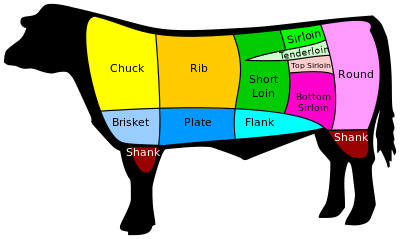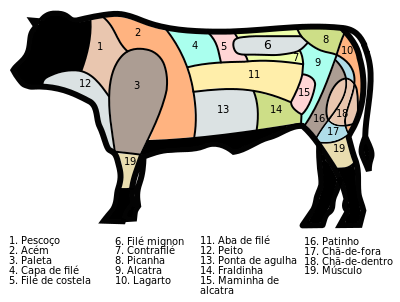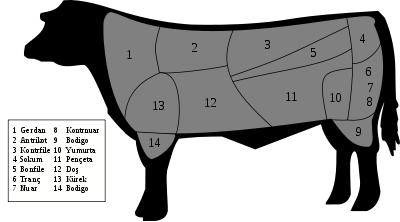Cut of beef
This article needs additional citations for verification. (October 2013) |
| Part of a series on |
| Steak |
|---|
Cuts of beef are first divided into primal cuts, pieces of meat initially separated from the carcass during butchering. These are basic sections from which steaks and other subdivisions are cut. The term "primal cut" is quite different from "prime cut", used to characterize cuts considered to be of higher quality. Since the animal's legs and neck muscles do the most work, they are the toughest; the meat becomes more tender as distance from hoof and horn increases. Different countries and cuisines have different cuts and names, and sometimes use the same name for a different cut; e.g., the cut described as "brisket" in the US is from a significantly different part of the carcass than British brisket. "Cut" often refers narrowly to skeletal muscle (sometimes attached to bones), but can also include other edible flesh, such as offal (organ meat) or bones without significant muscles attached.
American cuts

The following is a list of the American primal cuts (in boldface), and cuts derived from them. Beef carcasses are split along the axis of symmetry into "halves", then across into front and back "quarters" (forequarters and hindquarters). Canada uses identical cut names (and numbering) as the U.S.[1]
Forequarter cuts
- The chuck is the source of bone-in chuck steaks and roasts (arm or blade), and boneless clod steaks and roasts, most commonly. The trimmings and some whole boneless chucks are ground for hamburgers.
- The rib contains part of the short ribs, the prime rib and rib eye steaks.
- Brisket, primarily used for barbecue, corned beef or pastrami.
- The foreshank or shank is used primarily for stews and soups; it is not usually served any other way because it is the toughest of the cuts.
- The plate is the other source of short ribs, used for pot roasting, and the outside skirt steak, which is used for fajitas. The navel is the ventral part of the plate, and is commonly used to make pastrami. The remainder is usually ground, as it is typically a tough and fatty meat.
Hindquarter cuts
- The loin has two subprimals, or three if boneless:
- the short loin, from which the T-bone and porterhouse steaks are cut if bone-in, or strip steak.
- the sirloin, which is less tender than short loin, but more flavorful, can be further divided into top sirloin and bottom sirloin (including tri-tip), and
- the tenderloin, which is the most tender, can be removed as a separate subprimal, and cut into filet mignons, tournedos or tenderloin steaks, and roasts (such as for beef Wellington). They can also be cut bone-in to make parts of the T-bone and porterhouse loin steaks.
- The round contains lean, moderately tough, lower fat (less marbling) cuts, which require moist or rare cooking. Some representative cuts are round steak, eye of round, top round, and bottom round steaks and roasts.
- The flank is used mostly for grinding, except for the long and flat flank steak, best known for use in London broil, and the inside skirt steak, also used for fajitas. Flank steaks were once one of the most affordable steaks, because they are substantially tougher than the more desirable loin and rib steaks. Many modern recipes for flank steak use marinades or moist cooking methods, such as braising, to improve the tenderness and flavor. This, combined with a new interest in these cuts' natural leanness, has increased the price of the flank steak.
Argentine cuts
The most important cuts of beef in the Argentine cuisine are:[2]
- Asado: the large section of the rib cage including short ribs and spare ribs
- Asado de tira: often translated as short ribs, but also sold as long, thin strips of ribs. Chuck ribs, flanken style (cross-cut).
- Bife de costilla: T-bone or porterhouse steaks
- Bife de chorizo: strip steak, called NY strip in US
- Ojo de bife: ribeye steak
- Bola de lomo: tenderloin
- Chinchulín: upper portion of small intestines
- Colita de cuadril: tri-tip, or the tail of the rump roast
- Cuadril: rump
- Entraña: skirt steak
- Falda: navel
- Lomo: tenderloin
- Matambre: a long thin cut that lies just under the skin and runs from the lower part of the ribs to belly–or flank area
- Mollejas: sweetbreads (thymus gland)
- Pecho: brisket
- Riñones – kidneys
- Tapa de asado – rib cap
- Tapa de nalga – top of round roast
- Vacío – flank, though it may contain the muscles of other near cuts
Brazilian cuts

The most important cuts of beef in the Brazilian cuisine are:[3]
- Acém (2): neck
- Alcatra (9): top/bottom sirloin
- Contrafilé (7): tenderloin
- Coxão duro: round (upper)
- Coxão mole: round (lower)
- Filé Mignon (6): part of the tenderloin
- Lagarto (10): round (outer)
- Maminha (15): bottom sirloin/flank
- Patinho (16): confluence of flank, bottom sirloin and rear shank
- Picanha: rump cover or rump cap
- Cupim: hump (zebu cattle only)
- Fraldinha: confluence of short loin, flank and bottom sirloin
- Paleta (3): chuck/brisket
British cuts

- Tongue
- Necks and clod
- Chuck steak & blades
- Sirloin
- Rump
- Silverside
- Topside
- Top rump
- fore rib
- Rib eye steak
- T-bone steak
- Thick rib
- Thin rib
- Brisket
- Shin and leg
- Flank
- Thick flank
- Feather blade
- Fillet
Dutch cuts

- Neck
- Rib
- Sirloin
- Tenderloin – Considered to be the premium cut, highly prized. It is called 'ossenhaas' in Dutch. It tends to be cut slightly smaller than its American counterpart.
- Top sirloin
- Round – Mainly used for kogelbiefstuk ('hip joint steak') considered to be the basic form of steak in Dutch and Belgian cuisine.
- Flank
- Chuck – Best cuts are used for stoofvlees, lesser bits are used in hachee.
- Brisket
- Shankle
- Beef tongue is considered the cheapest piece of beef; it is used in certain styles of sausages such as the frikandel, though not as the main ingredient.
- Tail, though not on the image shown, is used extensively in stews.
French cuts

- Basses côtes (1)
- Côtes, entrecôtes (2)
- Faux-filet (3)
- Filet (4)
- Rumsteck (5)
- Rond de gîte (6)
- Tende de tranche ; poire, merlan (7)
- Gîte à la noix (8)
- Araignée (9)
- Plat de tranche, rond de tranche, mouvant (10)
- Bavette d'aloyau (11)
- Hampe (12)
- Onglet (13)
- Aiguillette baronne (14)
- Bavette de flanchet (15)
- Plat de côtes (16)
- Macreuse à bifteck (17)
- Paleron (18)
- Jumeau à bifteck (19)
- Jumeau à pot-au-feu (20)
- Macreuse à pot-au-feu (21)
- Queue (22)
- Gîte (23)
- Flanchet (24)
- Tendron, milieu de poitrine (25)
- Gros bout de poitrine (26)
- Collier (27)
- Plat de joue (28)
- Langue (29)
Korean cuts
See 쇠고기 and Know Your Beef Cut! for lists. The large number of "cuts" of beef in Korean is partly due to counting offal (organ meat) and bones, not only skeletal muscle.
Portuguese cuts

- Cachaço (1)
- Coberta do acém, acém comprido (2)
- Pá, peito alto (3)
- Maçã do peito (4)
- Peito (5)
- Chambão (6)
- Mão (7)
- Lombo (8)
- Rosbife, acém redondo, vazia, entrecôte (9)
- Prego do peito (10)
- Aba grossa (11)
- Alcatra (12)
- Chã de fora (13)
- Rabadilha (14)
- Pojadouro (15)
Turkish cuts
- Gerdan (1): neck

Turkish cuts of beef - Antrikot (2): rib steak
- Kontrfile (3): Steak
- Bonfile (5): fillet Steak
- Sokum (4): rump
- Nuar (7): round of beef
- Kontrnuar (8): the lower left side of nuar
- Tranç (6): the upper left side of nuar
- Kürek (13): shoulder
- Kol, incik: mutton leg
- Döş (12): brisket
- Pençata (11): flank
- Yumurta (beef) (10): the section between kontrnuar and pençata
UNECE standard for bovine meat carcasses and cuts
The UNECE standard offer for the first time internationally agreed specifications written in a consistent, detailed and accurate manner using anatomical names to identify cutting lines[4]
See also
References
- ^ "Beef Cuts by Chart". Clovegarden.com. Retrieved 18 December 2011.
- ^ Main Argentinian cuts
- ^ Cuts of Beef Served in Brazilian Steakhouses « « RodizioDirectory.Com RodizioDirectory.Com
- ^ UNECE STANDARD - Bovine meat carcases and cuts



